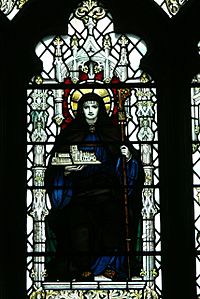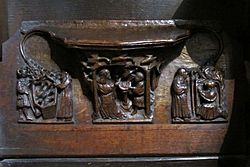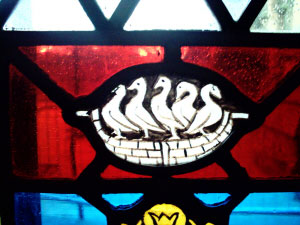Werburgh facts for kids
Quick facts for kids Saint Werburgh |
|
|---|---|

Saint Werburgh, Chester Cathedral.
|
|
| Born | ca. 650 Stone, Mercia |
| Died | 3 February 700 Trentham, Staffordshire, England |
| Venerated in | Eastern Orthodox Church, Anglican Communion, Roman Catholic Church |
| Major shrine | Hanbury then Chester Cathedral |
| Feast | 3 February |
| Patronage | Chester |
Werburgh (also Wærburh or Werburga) was an Anglo-Saxon princess who lived around 650 to 700 AD. Her name means "true city." She became a very important person and is known as the patron saint of the city of Chester in England. Her special day, or feast day, is celebrated every year on February 3rd.
Contents
The Early Life of Werburgh
Werburgh was born in a place called Stone, which is now in Staffordshire, England. Her father was King Wulfhere of Mercia, who was a Christian. Her mother was Saint Ermenilda, whose father was the King of Kent.
Werburgh was taught at home by Saint Chad, who later became a bishop. She also learned from her mother. From a young age, she wanted to dedicate her life to God.
She asked her father if she could join the Abbey of Ely. This abbey was a special religious community for women. It had been started by her great-aunt, Etheldreda, who was a famous abbess. Werburgh spent most of her life as a nun, living in places like Weedon Bec in Northamptonshire.
Werburgh's Work and Legacy
Werburgh played a big part in improving religious communities for women across England. She followed in the footsteps of her mother, grandmother, and great-aunt. She became the fourth Abbess of Ely, leading the abbey.
Werburgh passed away on February 3rd, 700 AD. She was buried in a place called Hanbury in Staffordshire.
The Miracles of Saint Werburgh

After Werburgh died, her brother Coenred became the king. In 708, he decided to move her remains to a more important spot in the church at Hanbury. When her tomb was opened, people were amazed to find her body perfectly preserved. This was seen as a sign that God favored her.
A year later, King Coenred gave up his throne and became a monk in Rome. Around this time, the most famous story about Werburgh became popular. It tells how she brought a dead goose back to life! This story was written down by a historian named Goscelin. There is even a stained glass window in a church in Weedon Bec that shows another story about her. In that tale, she was said to have made all the geese leave the village.
Werburgh's Shrine in Chester
The special place where Saint Werburgh's remains were kept, called her shrine, stayed in Hanbury for a while. But in the late 800s, there was a danger from Viking raids. To protect her remains, they were moved to the safe, walled city of Chester.
A shrine for Saint Werburgh was set up at the Church of St Peter and St Paul. This church is now known as Chester Cathedral. In 975, the church was rededicated to Saint Werburgh and another saint, Oswald. Later, a monastery was built next to the church.
By 1057, the church was rebuilt and given more support by Leofric, a powerful earl. By this time, Werburgh was seen as the special protector of Chester. People believed she performed a miracle when the Welsh king, Gruffudd ap Llywelyn, suddenly stopped attacking the city.
Even after the Norman conquest of England in 1066, people continued to visit Saint Werburgh's shrine. In 1093, Hugh d'Avranches, a Norman earl, gave gifts to the abbey and made the church bigger. He also started a Benedictine monastery there. During the Middle Ages, people who visited the shrine would wear a badge showing a group of geese. This showed they had made a pilgrimage to Saint Werburgh's special place.
In 1540, during a time called the Dissolution of the Monasteries, the abbey was closed. Chester Cathedral was then created. Although a beautiful shrine had been built for Werburgh in the 1300s, it was taken apart during this time. Her relics, or remains, were lost. However, some parts of the shrine's stonework were put back together in 1876. You can still see parts of the shrine today in the cathedral's Lady Chapel.
Saint Werburgh Today
Saint Werburgh is still known as the patron saint of Chester. Her feast day is still celebrated on February 3rd.
Many churches in England and even some in other countries are named after Saint Werburgh. These include churches in Dublin, Derby, and Spondon. The village of Warburton in Greater Manchester is named after its church of St Werburgh. There is also a neighborhood in Bristol called St Werburghs, named after its church, which is now a climbing center. In Manchester, a tram stop is named St Werburgh's Road because a church dedicated to her is nearby.
See also
- St Werburgh's Church (disambiguation)


